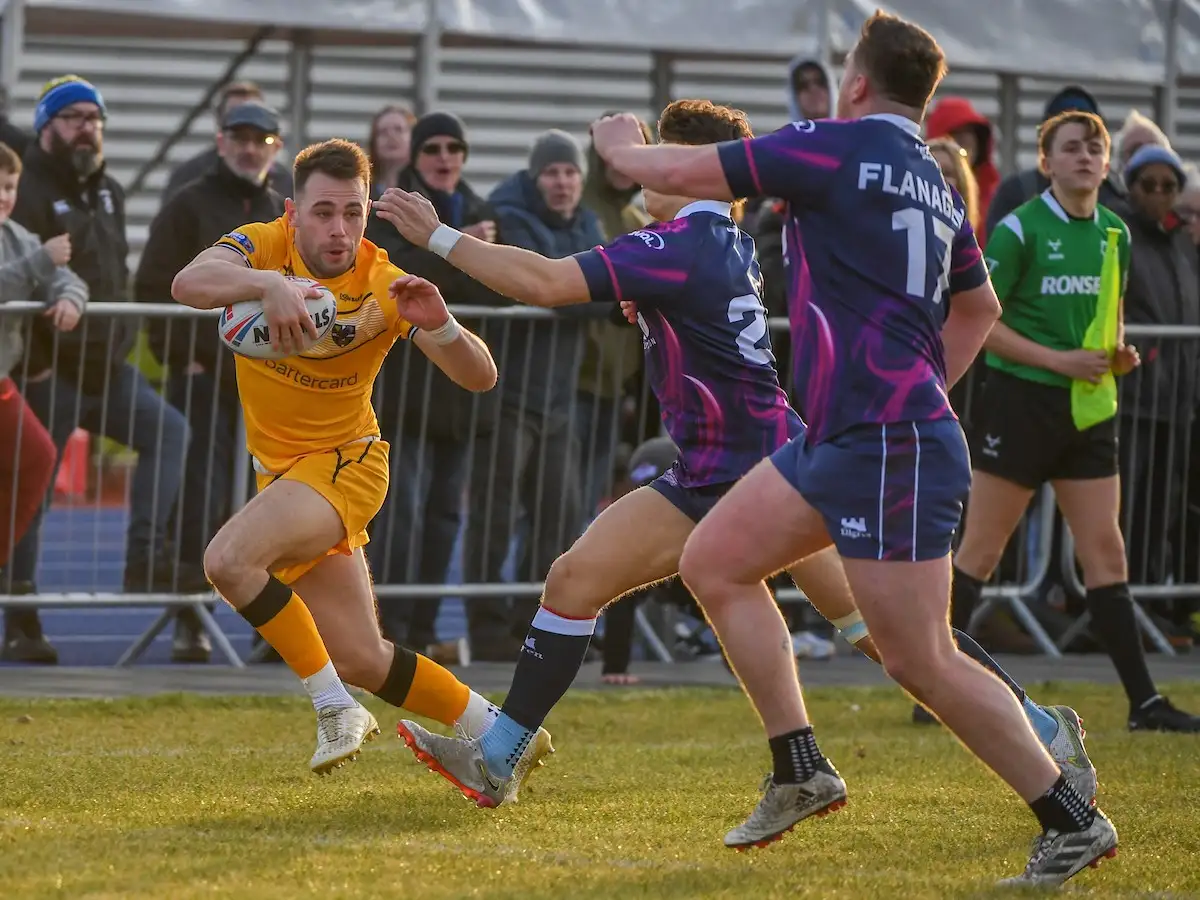Is rugby league’s “expansion division” being forgotten about?

Picture by Olly Hassell/SWpix.com
When you look at the teams that have gone through rugby league’s third tier (League 1) in the past decade or so, you wouldn’t have “M62 sport” at the forefront of your mind.
It has been the entry point to the RFL’s professional structure for the likes of Toulouse, Toronto Wolfpack and Crusaders, all of whom have eventually made it all the way up to Super League.
Former world champions Bradford even had a season in the division, while the spread of teams has consistently bettered the divisions above it – with London Skolars mainstays, Coventry Bears adding presence in the Midlands now as the Hurricanes and Cornwall taking it to the south west for the first time.
Gloucestershire All Golds, Hemel Stags and Oxford all had multiple seasons in the competition, and there was a second team in Wales – though sadly West Wales Raiders were forced to withdraw on the eve of the 2023 season.
There has been, ultimately doomed, interest from New York, Red Star Belgrade and Valencia Huracanes, while COVID halted plans for Ottawa Aces to join the league. Closer to home, Northampton Rebels, Manchester Rangers and Chester Gladiators have previously expressed interest in joining the division, with the Rebels initially accepted before withdrawing.
Is League 1 being taken seriously?
On the face of it, it looks like a blooming expansion plan to spread the reach of rugby league and encourage more teams to turn at least semi-professional.
But the reality is that of an ever-diminishing central funding hand out, a minimal calendar and an increasing gulf to even the Championship.
The departure of West Wales has both exacerbated and relieved some of the issues faced by the remaining 10 clubs in the division. While no south Wales team means less travel, it also means one less home fixture and two more blank weekends in a calendar that already has two bye weeks and space for Challenge Cup ties.
Doncaster chief Carl Hall, writing in the latest Forty-20 magazine, said: “It’s even tougher for clubs in the third tier these days. We’ve seen West Wales pull out, which only leaves 10 teams, and you hear rumours of uncertainty with one or two others. It might be a case of hands being forced and a need to extend the Championship, I honestly don’t know.
“Losing West Wales means more breaks in the season, meaning it is harder to get continuity and keep everyone motivated. That’s going to be a difficult one to manage, especially if we do go out of the Challenge Cup early.
“When you look at where we are going with the Challenge Cup, will we ever get the dream tie of playing a Super League club anymore? You have to ask yourself the question ‘are we really taken seriously?’
“League 1 is, in effect, rugby league’s expansion division, but that cost doesn’t get recognised in terms of distributions. I can see arguments on both sides, but without the community game and the lower leagues, where are the players going to come through from?
“Most clubs will tell you that we spend about a quarter of our distribution going to Cornwall. We get a travel grant, but if you factor in the accommodation, it’s expensive and we don’t get a great amount.
“The Championship has gone to another level. Bridging that gap has to be a concern for all of us in it.”
The current Challenge Cup format has League 1 clubs entering in the second round, before the Championship clubs in in the third round. The 12 Super League teams do not enter until the sixth round, making the chances of a League 1 side facing one very unlikely.
Last season, League 1 side North Wales Crusaders made the fifth round and were beaten by Sheffield. The revised format of the 1895 Cup also means League 1 clubs have little chance of progressing in that and reaching Wembley either. Even winning three cup games wasn’t enough to get Crusaders in to the last four of the 1895 Cup, which was contested between Leigh and Featherstone at the Tottenham Hotspur Stadium in 2022.
Central funding distribution
The distribution of the Sky TV monies has been a key sticking point in recent years, and partly contributed to the decision for the RFL and Super League to separate.
The two have since re-aligned as part of the new RL Commercial body and IMG’s involvement, though the argument continues from the clubs in the top flight that the TV money is earned by them and they need it to ensure their competition continues to move forward.
League 1 clubs can take some solace from the progress shown by Barrow following their promotion to the Championship, where they made the play-offs in their first season, while Keighley are fancied to do well in 2023.
York and Toulouse have previously immediately established themselves at the top end of the second tier following successful seasons in League 1.
But without money filtering down, it’s going to be a major struggle for League 1 to maintain its semi-professional status moving forward. Some argue that the quality of the amateur National Conference League is greater.
In terms of rugby league expansion, it should be more the merrier. Midlands Hurricanes are gradually seeing the benefits of the years of Coventry Bears development, adding to the player pool, which is crucial to the long-term survival of rugby league.
They benefit from being able to go up against teams from the traditional heartlands, like Hunslet and Workington, rather than being marginalised in a lower quality regional amateur set up.
The trouble is at the moment that adding more teams, means the slice of the pie gets even smaller. Manchester Rangers, playing out of the community stadium next door to Manchester City’s Etihad Stadium, were rejected years ago due to the presence of Oldham, Rochdale and Swinton in the vicinity.
But without this feasible entry point, the only way for expansion teams to join would be to bulldoze their way in to Super League – and if that simply means chucking players at existing players rather than doing the hard yards to develop the grassroots of the game, it doesn’t seem like a strategy that rugby league can sustain for long.
Hall references a possible merger with the Championship, which at present numbers, would create a 24-team division. There would be a significant gulf between the likes of Toulouse and Featherstone at the top, to London Skolars and Cornwall at the other end.
What the answer is remain to be seen. League 1 clubs will hope that IMG have it, and it can then maybe fulfil its unofficial purpose for years to come.
READ NEXT: Cornwall land airline deal that Super League lacks



